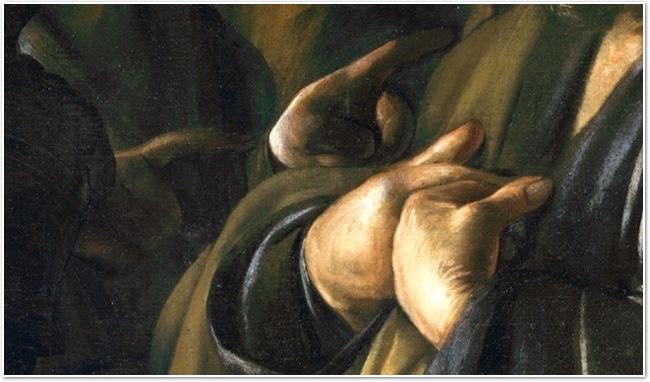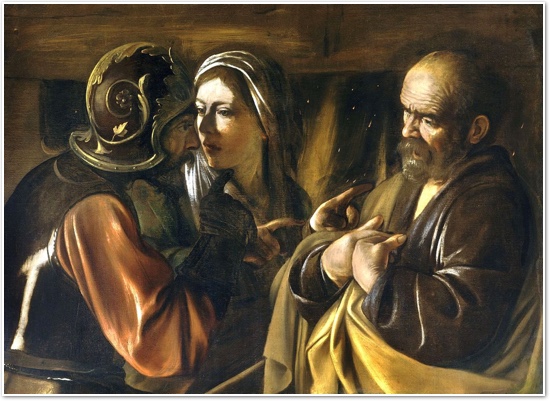What Did the Public and the Religious Establishment Think of Caravaggios Art?
The intimate relationship that an artist has with their work can at times seem disconnected.
 The Denial of Saint Peter (1610)
The Denial of Saint Peter (1610)
Caravaggio (Michelangelo Merisi, 1571-1610),
Metropolitan Museum of Art, New York.
This peradventure describes the relationship that Caravaggio had with his religious works.
His religious art delved into some of the most profound theology always executed on canvas, yet his personal devotion seemed to be less than nominal. How exactly does information technology happen that such an "irreligious" artist can transmit theological truths? Possibly this tin can but be answered by the words of Jesus himself to Pontius Pilate, heard every Proficient Friday in the Gospel of John: Everyone who belongs to the truth listens to my vox(Jn 18:37). An artist who taps into something transcendent belongs to the truth, and that truth is but the Person of Jesus Christ, whether the artist realizes information technology or not.
Michelangelo Merisi was born outside of Milan on September 29,1571, in a small farming community known as Caravaggio. Upon moving to Rome in 1592, the painter soon became known by the town of his origin. Caravaggio plant early on back up in Rome from families and clergy who were directly or indirectly connected to his time in northern Italian republic. These connections exposed him to diverse ecclesial traditions within Catholicism. During the time of the Counter-Reformation, a renewal of religious life blossomed among the Jesuits, Franciscans, and Augustinians. The ideas promulgated by these orders influenced Caravaggio as he transitioned from secular to religious painting.
The Alliance of the Little Oratory, founded and led by Saint Philip Neri (1515-1595), provided the greatest and most lasting impact on Caravaggio's theological perspective. The Oratory evolved into a customs of priests and lay persons who gathered regularly for liturgical prayer, sermons and lectures, concerts, and other artistic events. All of these activities were promoted with the idea that skilful liturgy, preaching, and fine art were meant for everyone —especially the poor and the uneducated. The Oratory regularly attracted artists in Rome, and Caravaggio was no exception.
Irreligious religious fine art
Because of the unconventional style in which he painted and his use of "inappropriate" models and images, the offset religious paintings of Caravaggio were not received well by his patrons. His creative fashion embraced a heightened chiaroscuro, known as tenebrism, which imposed a stark dissimilarity between light and darkness. His models were known prostitutes whom Caravaggio painted as saints (including the Blessed Mother!), and his frequent display of peasants with dirty feet appalled viewers and critics alike.
Yet the manner in which Caravaggio executed his religious art in itself revealed a powerful truth. The painter conveyed a radical sense of incarnational theology that emphasized the Light (Jesus Christ) shining in the darkness (the world). God fully embraced the sinful condition of humanity past condign human being in the Person of Jesus Christ. As Philip Neri sought to bring the poor, the downtrodden, and the sinner closer to an awareness of God, Caravaggio sought to bring the poor, the downtrodden, and the sinner to the awareness of the affluent and spiritually snobbish.
The Deprival of Saint Peter
In The Deprival of Saint Peter, the sinner who Caravaggio highlights is, of form, Peter himself. The creative person masterly relates the narrative, which is establish in all iv Gospels (Mt 26:69-75; Mk fourteen:66-72; Lk 22:54-62; and Jn eighteen 15-eighteen, 25-27. The faint flicker of the fire in the background situates the scene in the high priest's courtyard. The left-to-right action unfolds the charge that Peter was a disciple of Jesus. The adult female pointing twice at Peter suggests the ii times the maid approaches Peter (equally described in the Marcan account). The presence of the soldier (who is not explicitly mentioned in any of the Gospels) heightens the suspense of the accusation. The soldier, dressed in a uniform gimmicky to the creative person'south time, situates the current viewer in the scene and suggests that the event is diachronic in nature. His pointed finger combines with the maid's two fingers to symbolize the three denials that Jesus predicted Peter would brand before the cock crowed.
Peter, on the receiving end of the accuse, points to himself, in a common Caravaggio pose that seems to say, "Who? Me?" Peter's appearance also seems reminiscent of Socrates (a figure often employed by Caravaggio).
The resemblance would be an appropriate connection. Socrates was famously thought to take quipped, "I know that I know naught," as Peter adamantly responds to his accusers, I do non know what you are talking about!
Caravaggio in the shadow of Peter
While Caravaggio succinctly captures the narrative, he more than significantly captures the brokenness of Peter. Ane does not sense an belligerent Peter, simply rather a humiliated ane. Without even knowing the story, information technology is easy to read this painting: two people pointing at a guilty man. The enshrinement of a sinner on the sheet is Caravaggio's specialty, perhaps because the creative person himself could readily identify with Peter in his wounded nature.
Caravaggio spent nigh of his life every bit a human on the run. When he left his hometown for Rome, he quickly made his marker on the fine art scene, only to find himself soon in trouble with the law. Subsequently murdering a human following a tennis lucifer, he fled Rome and eventually establish refuge with the Knights of Republic of malta. While winning the favor of the Thou Principal of the Knights, his erratic and volatile behavior afterwards landed him in prison. He escaped to Naples, where he nigh likely painted The Denial. The work, executed shortly before the artist's untimely death at the age of thirty-eight, embodies Caravaggio'southward own life of paradox.
An innovative and daring painter, Caravaggio was a darling of both the aristocracy and the clergy who ultimately could not go a handle on his passions. Peter, a human as well filled with passion and zeal, stumbled when that passion meant persecution and possible decease. Both men belonged to the truth considering they each knew their particular vocation; withal, their weaknesses prove that man frailty tin can only be overcome by uniting one's self to the Passion of Jesus Christ.
Source: https://www.catholiceducation.org/en/culture/art/caravaggio-the-theologian.html

0 Response to "What Did the Public and the Religious Establishment Think of Caravaggios Art?"
Post a Comment